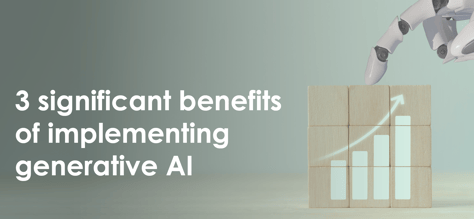3 major concerns of integrating generative AI

Generative AI revolution
At Premier CX, we have been closely following and participating in the generative AI revolution. We are especially interested in OpenAI’s ChatGPT and the subsequent AI tools that have emerged.
In addition to utilising generative AI in a portal for our sister company, we have immersed ourselves in its applications, its strengths and weaknesses, and how to provide AI integration solutions for our clients.
Let’s delve deeper…
The use of generative AI has been a hot topic in the past year, as many people have explored its possible advantages, such as its speed, agility, and growing knowledge base.
But generative AI also poses some challenges.
How can we deal with these issues and ensure that the benefits are greater than the risks?
With our guest host, Gerry Brown, Chief Customer Rescue Officer at The Customer Lifeguard, we held an engaging discussion with four experts from the CX industry about this subject.
The 3 major concerns…
Let’s jump straight in to the first one.
1. Data Security & Privacy:
Ensuring the security of customers' confidential information is of utmost importance when integrating any new system.
The implementation of GDPR (General Data Protection Regulation) in the UK in 2018 marked a significant step to safeguard the data of all UK citizens.
Nonetheless, given our limited understanding of the long-term impact of generative AI, a major concern arises: how can we guarantee with absolute certainty that customer data will remain secure when implementing generative AI within our internal corporate systems?
‘As a local authority, obviously privacy and data security is a big concern for us…’ Sarah Williams, Chief Customer Experience Officer from Westminster City Council.
Experience Officer from Westminster City Council.
In the highly regulated industry of energy, Darren Jeffery, Head of Customer Operations from Smartest Energy Business explains, ‘Risks such as security, privacy, bias, inaccuracy of data or information that’s being supplied. And I think it’s security and privacy concerns, it’s how the generative AI may store the data improperly, where there is some nervousness.
We need to know what additional robust measures need to be taken in order to mitigate those security and privacy concerns.’
2. Digital inclusivity & accessibility:
Another major concern is digital inclusivity and accessibility.
In recent years, there has been a growing recognition of vulnerabilities, encompassing a better understanding of their nature and how they affect individual customers.
The recent FCA (Financial Conduct Authority) legislation in the UK underscores the obligation for companies to take responsibility for every interaction with their customers, guaranteeing accessibility.
This ties directly into the introduction of AI, with so many areas for concerns for vulnerable customers, we need to ask, how can it be implemented to ensure accessibility remains a top priority in customer interactions.
Chris Nicholson, Contact Transformation Manager from Riverside Housing explains, ‘We’re considering a number of factors including accessibility; do I know how to do it? Skill vs will…
This digital inclusivity question for customers in a cost-of-living crisis. Do they have access to the internet? Can they afford to use the internet on their mobile phones, are really massive, massive factors for us.’
3. Trust: AI adoption & the human touch:
Following the last 3 years of significant change, UK contact centres are still finding their feet. This adjustment is being felt by customers.
From the sudden need to implement automated support – for many this was an out-of-the-box solution, many chatbots were introduced and failed.
Customers found themselves interacting with chatbots as the initial point of contact, only to discover that these bots were not only incapable of providing satisfactory answers, but also struggled to comprehend their queries.
Although these chatbots did not employ generative AI, the experience may have left a negative impression on the channel's credibility, potentially influencing future adoption.
‘Our customers are human beings… Getting a digital journey wrong, certainly a bot journey wrong, where you don’t have a human-to-human interaction will damage trust completely.
You’ve got to get it right and realise that actually a human to non-human engagement still has to be humanlike in terms of that conversational style. That’s the biggest risk, trust, and then the adoption rate drops.
Once you get that negative experience it’s very, very hard to get that customer to reengage with that channel.’ Sally Greenaway, Customer Experience Director at Premier CX
To summarise…
It is evident that the world is increasingly moving towards AI, underscoring the importance of dialogues like this one.
These discussions are crucial in comprehending concerns and finding solutions to address them.
Sarah Williams explains, ‘The key thing is understanding the use case. Understanding what it is that you’re trying to solve. Test and iterate it with your users to make sure that actually they’re comfortable and confident with what you’re implementing.’
Once we understand if our customers desire and require AI, it becomes imperative to ensure its introduction is:
1. Secure2. Inclusive
3. Has a foundation of trust
And it’s essential to remember that achieving this goal necessitates the presence of a human in the loop. Humans can provide oversight, quality assurance, and intervention when needed to ensure that generative AI is used in a responsible and ethical way.
Humans can also complement generative AI by providing empathy, creativity, and expertise that are beyond the capabilities of current AI systems.
What’s next?
Considering these core 3 concerns, we want to explore the flip side.
After all, the drive behind addressing and resolving these concerns stems from the significant benefits that AI could bring to the contact centre.
Look out for the next article sharing the top 3 advantages of implementing generative AI in contact centre operations!
Thank you to…
We’d like to thank all the panellists of the round table for such an informative and invaluable discussion.
- Chris Nicholson, Contact Transformation Manager, Riverside Housing
- Sarah Williams, Chief Customer Experience Officer, Westminster City Council
- Darren Jeffery, Head of Customer Operations, Smartest Energy Business
- Sally Greenaway, Customer Experience Director, Premier CX
And, of course, Gerry Brown, Chief Customer Rescue Officer at The Customer Lifeguard, for so brilliantly hosting the panellists.
If you need advice on how to integrate generative AI into your contact centre operations, please get in touch.
Written by:
The Premier CX Team